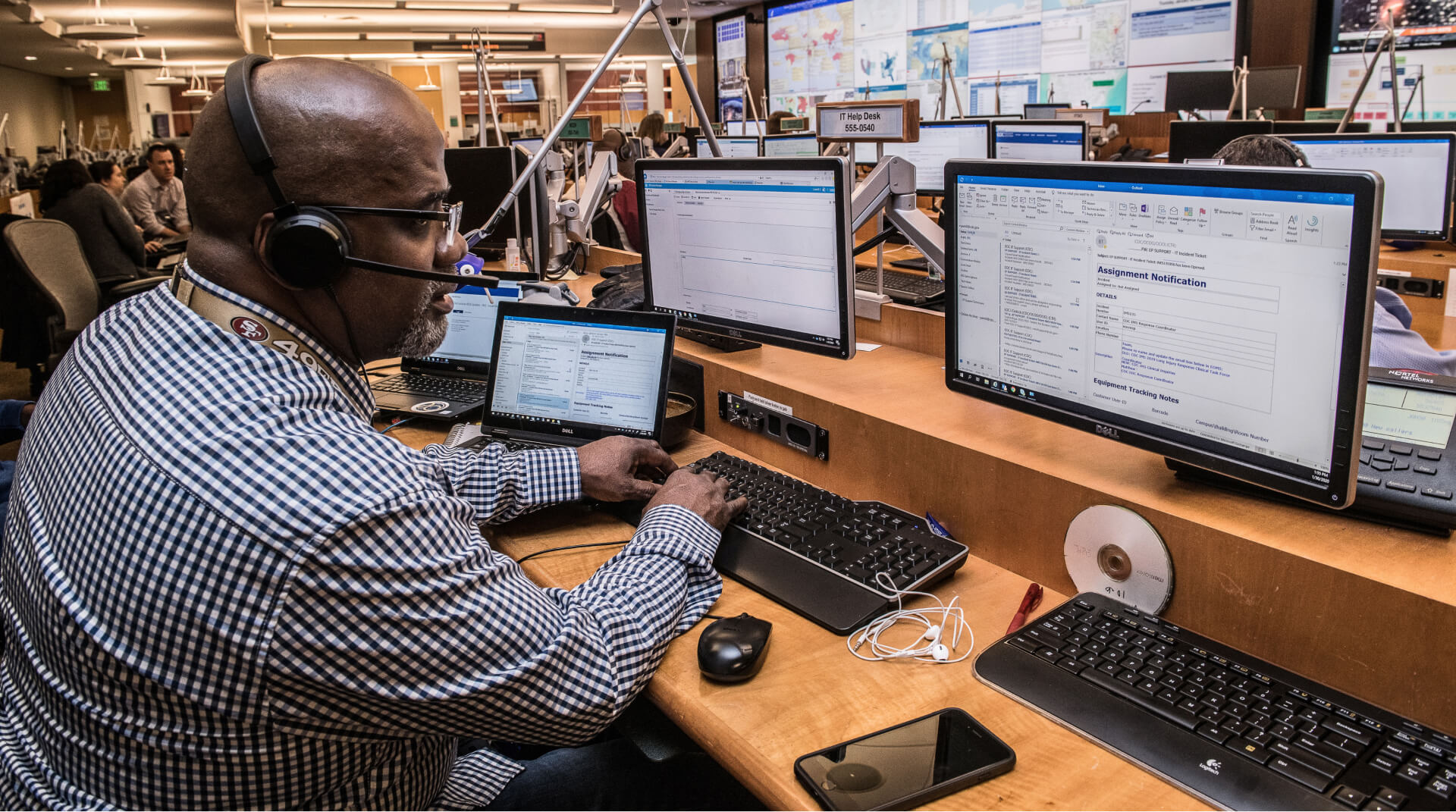Omnichannel Contact Center

Omnichannel is a much-discussed topic that raises a lot of different questions. We have picked out the following main questions to go into more detail on the topic of omnichannel for companies.
- What does omnichannel mean?
- What are the advantages of an omnichannel solution?
- For the customer? For the company? For the employees?
- What are the technical requirements for Omnichannel?
- How does target-oriented omnichannel management work?
- Can omnichannel solutions optimize work processes in the company and how?
- What is the difference between multichannel and omnichannel solutions?

Omnichannel - the future of customer service or already commonplace?
Omnichannel has been one of the key terms in the functional description of contact centers for several years. This is because the merging of different channels is revolutionizing every company's customer service. Example: If a customer has first discussed their concerns with the hotline, then switches to e-mail contact, they should be able to receive further advice seamlessly this way without having to describe their problem again.
The goal of this networking is to give the customer maximum flexibility to interact with your company. The customer feels very well taken care of and the buying process is completed more easily and quickly with simplified communication channels. This is because omnichannel solutions offer customers a seamless and consistent brand experience across all channels. In doing so, users can use the channels in parallel and thus act across channels. All customer and inventory data is synchronized in a central system and is available on all communication channels and at all touchpoints of the customer journey. This is an essential point when it comes to a customer's purchase decision, because nowadays customers go through several paths until the purchase process is finally completed.
But even today, customers tend to be pleasantly surprised when customer service responds specifically to all inquiries, which should generally be taken for granted. Why is that? What is driving progress and what is holding it back? Why doesn't every company with active customer contact use omnichannel solutions?
What is an omnichannel?
In short, it is the merging of all communication channels like: Calls, emails, live chats, WhatsApp chats, messenger etc. in one communication run. Customers have the opportunity to contact customer service through many channels. Document upload, video communication, chatting - communication adapts to the needs of customers. You can find an extensive description of the term and a number of examples of its technical use on our blog: https://www.softbcom.de/blog/callcenter-als-touchpoint-heute-omnichannel-und-soziale-netzwerke.
What is the difference between multichannel and omnichannel?
In multichannel solutions, as opposed to omnichannel, work is performed in contact centers with different channels through different means of communication that are not interconnected. Data about the same customer is not integrated into a single history. Therefore, the contact center agent must make significant efforts to compare all the different information arriving on different channels, synchronize them and, based on them, create an overall picture of the issue under discussion.
What are the benefits of a Unified Agent Desktop?
Omnichannel advantages for the customer
For the customer, an omnichannel solution is a wonderful customer service experience. No matter where and in what circumstances the customers are, they can communicate with the company from any channel. The communication channels become more diverse and easier, and the customer feels in good hands all around.
If calling is impractical (e.g. in public traffic or at work), the customer can send a request via a text channel. The agent has the address of the requested department sent via SMS during the call. A document or photo is sent via email or attached to a message via WhatsApp. Writing a short message in the chat is always much faster than calling the call center.
Omnichannel removes all communication barriers between the company and its customers, making this method of communication extremely beneficial for both parties.
By the way, WhatsApp is a channel that has gained immense popularity in recent years. This is one reason why the messenger is now increasingly finding its place in business communication as well. In our article the Business API of WhatsApp, you will find a detailed description of how this function can also enrich your contact center.
Summary of omnichannel advantages for the customer
Omnichannel solutions offer customers the opportunity to use modern communication channels in addition to calling or sending an e-mail. Video communication. Document upload, photos - they can switch between communication channels and still the customer service representative always knows exactly what their concern is and can follow up on the last communication.
Omnichannel solutions Advantages for companies
The advantages of an omnichannel solution for companies are clear. Omnichannel allows the customer to express their requests easier, faster, to get the answers faster and, among other things, to make the purchase decisions easier. In this way, the company can more easily attract a new customer!
Advantages for the service staff
By bundling all channels, it is easier for service staff to process customer inquiries directly and competently. All important information can be found directly and without detours at a glance. „Unified Agent Desktop“. Consolidated communication history on the same screen lets you grab the essence of the problem faster. No long familiarization with different tools or long researching what the current status is. This way, work resources can be better allocated, it saves time and communication with customers becomes easier as you can provide them with solutions directly - thus achieving higher customer satisfaction and better customer retention.
The information collected in the omnichannel solution provides a wide range of optimization opportunities and analysis.
- How long did the customer have to wait for his first answer?
- Which channel do customers prefer the most?
- How can we respond even better to the needs of our customers?
In order to reduce the workload of each service employee to a minimum, automation plays an important role. The easiest way is to have uniformity of settings: for example, the IVR logic for different channels as well as the agent interface can be created in the same way, which saves configuration efforts. There are already graphical developer tools for the agent interface and IVR, pre-built widgets for the agent screen, templates and pre-built reports and much more, which can be used and facilitate customization. Deploying an omnichannel solution offers a wide range of possibilities to build and optimize the work environment of a service agent and most importantly, it is customized to the needs of your business.
Actually, all companies with an active customer service should already have an omnichannel system in place. Many companies shy away from using omnichannel management because implementation is usually not always easy and requires a lot on the technical side, despite the far-reaching benefits.
So what is the reason why omnichannel solutions, which deliver benefits on both sides, are still the exception rather than the solution in practice?
There are some challenges and obstacles. Many companies are afraid of the costs, are unsure whether their technical company environment can easily integrate an omnichannel solution and do not see the benefits clearly enough. Nevertheless, we can show you that the most modern level of development in the industry is able to eliminate the cause of such fears.
So, where are the main obstacles?
The following analysis is based on the experience of communicating with real customers and successfully implementing omnichannel projects.
Many companies have a high technology barrier to entry and a limited offering. An omnichannel solution includes a wide range of functions, and not many companies are already using them. In addition, certain requirements must be ensured for all systems at the enterprise level in terms of reliability, security and flexibility.
What are the technical requirements for Omnichanel?
The system must meet the following requirements:
- The system must be fault tolerant,
- Enable cloud and on-premise installation options,
- Maintain a distributed structure of offices and branches of the company,
- ensure a high SLA,
- have a minimum of downtime,
- linear scaling with increasing load,
- Interface for integration with external systems in all phases of post-processing, etc.
In order to maintain the functionality of the system at all times and to quickly and effectively resolve problems that occur during operation, a support employee should always be quickly available. In this course, training in the system is necessary.
In addition, the omnichannel solution does not replace the complete use of a quality management system - nevertheless, the system facilitates the work of the service employee as well as the communication with customers or potential new customers!
All these requirements together form a set of conditions that unfortunately not every company can fulfill. That's why there are so few companies on the global market that are revolutionizing their customer service with innovative omnichannel solutions.
Not every omnichannel systems provider offers innovative solutions that can easily take companies to the next level in customer service.
